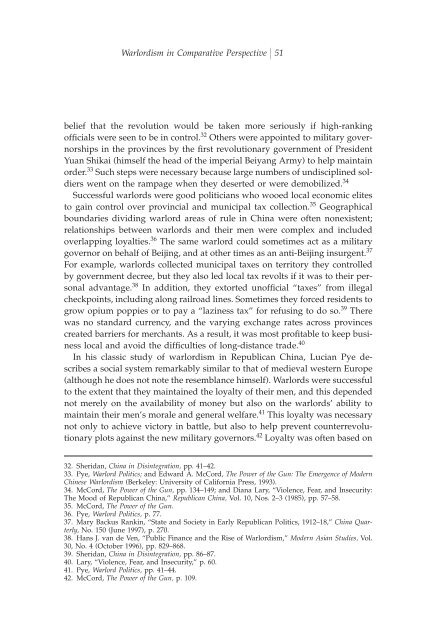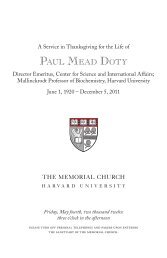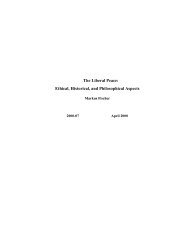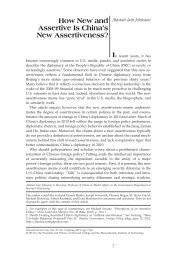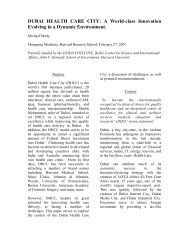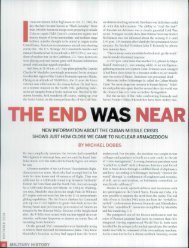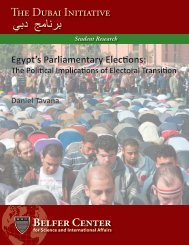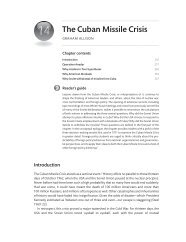Warlordism in Comparative Perspective - MIT Press Journals
Warlordism in Comparative Perspective - MIT Press Journals
Warlordism in Comparative Perspective - MIT Press Journals
You also want an ePaper? Increase the reach of your titles
YUMPU automatically turns print PDFs into web optimized ePapers that Google loves.
<strong>Warlordism</strong> <strong>in</strong> <strong>Comparative</strong> <strong>Perspective</strong> 51<br />
belief that the revolution would be taken more seriously if high-rank<strong>in</strong>g<br />
ofªcials were seen to be <strong>in</strong> control. 32 Others were appo<strong>in</strong>ted to military governorships<br />
<strong>in</strong> the prov<strong>in</strong>ces by the ªrst revolutionary government of President<br />
Yuan Shikai (himself the head of the imperial Beiyang Army) to help ma<strong>in</strong>ta<strong>in</strong><br />
order. 33 Such steps were necessary because large numbers of undiscipl<strong>in</strong>ed soldiers<br />
went on the rampage when they deserted or were demobilized. 34<br />
Successful warlords were good politicians who wooed local economic elites<br />
to ga<strong>in</strong> control over prov<strong>in</strong>cial and municipal tax collection. 35 Geographical<br />
boundaries divid<strong>in</strong>g warlord areas of rule <strong>in</strong> Ch<strong>in</strong>a were often nonexistent;<br />
relationships between warlords and their men were complex and <strong>in</strong>cluded<br />
overlapp<strong>in</strong>g loyalties. 36 The same warlord could sometimes act as a military<br />
governor on behalf of Beij<strong>in</strong>g, and at other times as an anti-Beij<strong>in</strong>g <strong>in</strong>surgent. 37<br />
For example, warlords collected municipal taxes on territory they controlled<br />
by government decree, but they also led local tax revolts if it was to their personal<br />
advantage. 38 In addition, they extorted unofªcial “taxes” from illegal<br />
checkpo<strong>in</strong>ts, <strong>in</strong>clud<strong>in</strong>g along railroad l<strong>in</strong>es. Sometimes they forced residents to<br />
grow opium poppies or to pay a “laz<strong>in</strong>ess tax” for refus<strong>in</strong>g to do so. 39 There<br />
was no standard currency, and the vary<strong>in</strong>g exchange rates across prov<strong>in</strong>ces<br />
created barriers for merchants. As a result, it was most proªtable to keep bus<strong>in</strong>ess<br />
local and avoid the difªculties of long-distance trade. 40<br />
In his classic study of warlordism <strong>in</strong> Republican Ch<strong>in</strong>a, Lucian Pye describes<br />
a social system remarkably similar to that of medieval western Europe<br />
(although he does not note the resemblance himself). Warlords were successful<br />
to the extent that they ma<strong>in</strong>ta<strong>in</strong>ed the loyalty of their men, and this depended<br />
not merely on the availability of money but also on the warlords’ ability to<br />
ma<strong>in</strong>ta<strong>in</strong> their men’s morale and general welfare. 41 This loyalty was necessary<br />
not only to achieve victory <strong>in</strong> battle, but also to help prevent counterrevolutionary<br />
plots aga<strong>in</strong>st the new military governors. 42 Loyalty was often based on<br />
32. Sheridan, Ch<strong>in</strong>a <strong>in</strong> Dis<strong>in</strong>tegration, pp. 41–42.<br />
33. Pye, Warlord Politics; and Edward A. McCord, The Power of the Gun: The Emergence of Modern<br />
Ch<strong>in</strong>ese <strong>Warlordism</strong> (Berkeley: University of California <strong>Press</strong>, 1993).<br />
34. McCord, The Power of the Gun, pp. 134–149; and Diana Lary, “Violence, Fear, and Insecurity:<br />
The Mood of Republican Ch<strong>in</strong>a,” Republican Ch<strong>in</strong>a, Vol. 10, Nos. 2–3 (1985), pp. 57–58.<br />
35. McCord, The Power of the Gun.<br />
36. Pye, Warlord Politics, p. 77.<br />
37. Mary Backus Rank<strong>in</strong>, “State and Society <strong>in</strong> Early Republican Politics, 1912–18,” Ch<strong>in</strong>a Quarterly,<br />
No. 150 (June 1997), p. 270.<br />
38. Hans J. van de Ven, “Public F<strong>in</strong>ance and the Rise of <strong>Warlordism</strong>,” Modern Asian Studies, Vol.<br />
30, No. 4 (October 1996), pp. 829–868.<br />
39. Sheridan, Ch<strong>in</strong>a <strong>in</strong> Dis<strong>in</strong>tegration, pp. 86–87.<br />
40. Lary, “Violence, Fear, and Insecurity,” p. 60.<br />
41. Pye, Warlord Politics, pp. 41–44.<br />
42. McCord, The Power of the Gun, p. 109.


